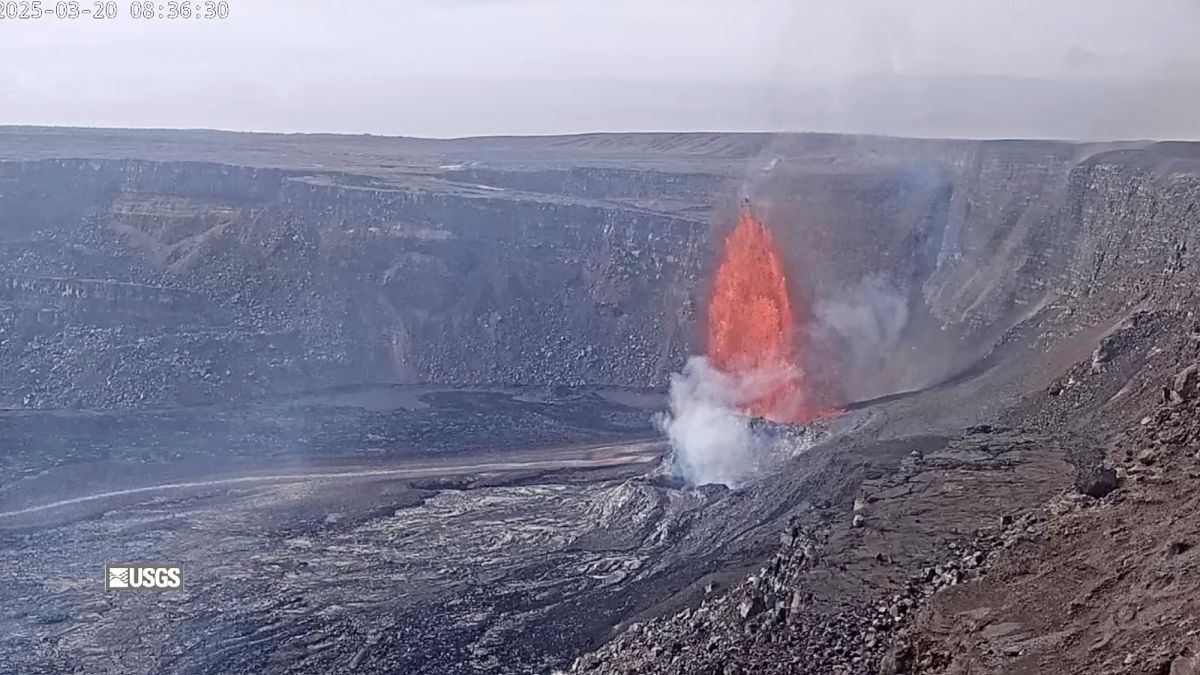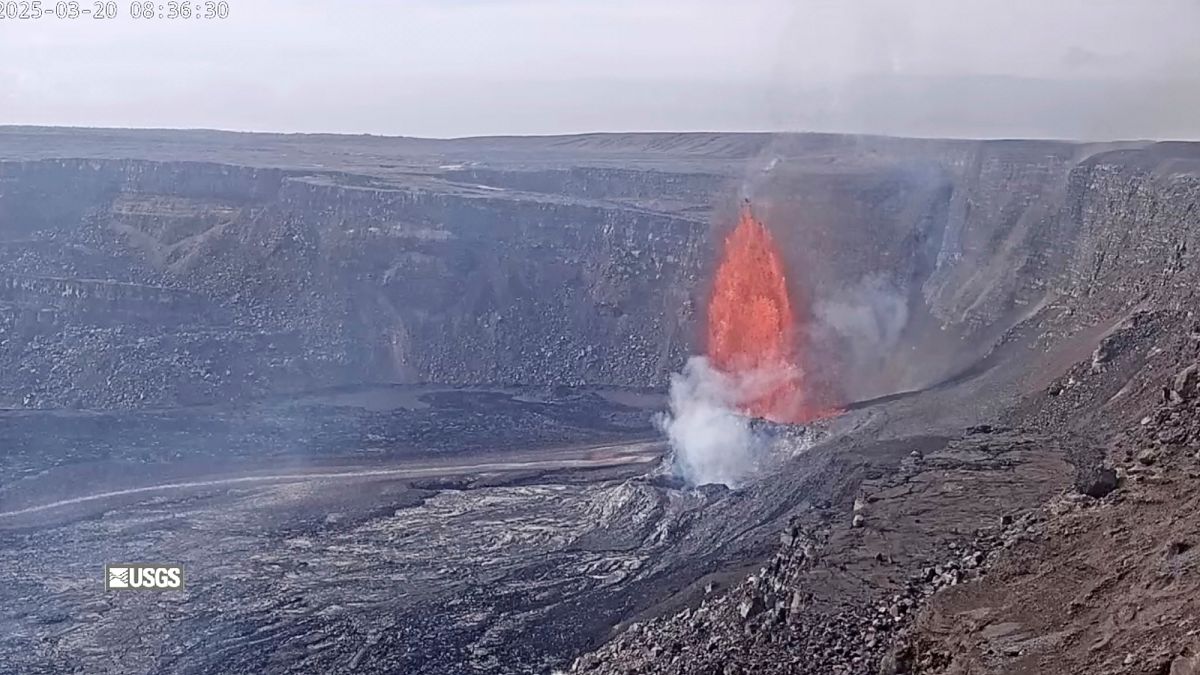Travel
Hawaii’s Kilauea volcano erupts again, no threat to residents

Hawaii’s Kilauea volcano erupts again, no threat to residents

Lava fountains shoot up during the March 20, 2025 episode in the ongoing eruption of Kilauea. – Copyright United States Geological Survey via AP
Copyright United States Geological Survey via AP
By Euronews with AP
Published on •Updated
Share this article
Copy/paste the article video embed link below:Copied
Kilauea ramped up its surface activity on Tuesday when lava began pouring out of a vent in its caldera.
Lava began bubbling out of Hawaii’s most active volcano once again on Tuesday as Kilauea’s sporadic eruption resumed.
The eruption restarted at midday when when molten rock began pouring out of a vent in Kilauea’s summit, the Hawaiian Volcano Observatory said in a statement. The lava was contained within the caldera inside Hawaii Volcanoes National Park and wasn’t affecting any residential areas.
The volcano on the Big Island of Hawaii has been erupting on-and-off since 23 December. It has shot tall fountains of lava high into the air, spilling molten rock across the caldera floor each time it comes back to life.
The spectacle is a popular attraction for tourists.
The current episode is the 15th of the current eruption. The shortest of the previous episodes lasted 13 hours and the longest for eight days; while pauses in between episodes have ranged from 24 hours to 12 days.
Kilauea is one of six active volcanoes in Hawaii, including one submerged underwater. The largest is Mauna Loa, which is also on the Big Island and which erupted in 2022.
Watch the video in the player above to find out more.
Go to accessibility shortcuts
Travel
Croatia’s ‘party island’ is cracking down on noise. Here’s what it means for your summer holiday
There are also several tourist regulations on clothing and behaviour that visitors should be aware of if they don’t want to receive a fine.
Croatia is the latest country to join the Europe-wide pushback against unruly tourists.
The island of Hvar, known as a popular nightlife spot, is now taking steps to curb the antisocial behaviour that comes with its reputation.
In a bid to move away from party tourism, Hvar (the town which shares a name with the island) has voted to maintain noise restrictions for the summer, which will have a significant impact on clubs, discos and outdoor venues.
There are also several tourist regulations on clothing and behaviour that visitors should be aware of if they don’t want to receive a fine.
Hvar is rebranding itself as a family-friendly destination
Last week, Hvar town councillors voted to maintain restrictions during the summer that limit noise to 85 decibels.
Given this is equivalent to a noisy restaurant, it will mean significant changes for the island’s popular outdoor clubs that open during peak season – as well as restaurants that host outdoor weddings.
The decision reportedly received pushback from restaurants, bars and other businesses. It was met with lobbying from the hospitality sector, which proposed instead to bypass noise rules by declaring the entire island a year-round entertainment zone, local news site CroatiaWeek reports.
“I think this is a disaster. We have always supported stricter rules and better monitoring, but now we are going from one extreme to another. This is not the right approach,” Vicko Visković from the hospitality association Dictum Factum told Croatian news site Dnevnik.hr.
But local authorities want to signal a shift towards a more family-friendly and sustainable tourism model.
“In previous years, open-air clubs in Hvar and Split may have encouraged excessive partying among guests and contributed to a ‘party destination’ image in Croatian tourism,” says Darijo Šarić, CEO of luxury villa rental site VIP Holiday Booker.
“However, Croatia has increasingly built a reputation for being a family-friendly destination, offering cultural richness, natural beauty, and a relaxed atmosphere.”
Tourists can be fined up to €700 on the spot for these offences in Croatia
The restrictions come amid a wider push for quality tourism across Croatia that benefits local residents.
In many town centres, including Split and Dubrovnik, you can get on-the-spot fines of up to €700 for behaviour deemed inappropriate. This includes drinking alcohol or using drugs in public spaces, urinating or vomiting in public spaces, and walking through towns shirtless or in swimwear.
You can also be fined up to €4,000 for public order disturbances, including fighting, verbal abuse such as shouting or arguing, and drunken behaviour.
Removing noble pen shells – a critically endangered species that plays a key role in the Mediterranean ecosystem – from Croatia’s beaches comes with a €67 fine per shell.
“These fines are intended more to deter bad behaviour rather than to punish anyone,” Šarić says. “Ultimately, it is about being responsible, ensuring Croatia remains a cherished, safe, and welcoming destination for everyone.”
Travel
The European tube: Inside the project to launch a continent-wide rail system by 2040
21st Europe’s Starline network plans to connect 39 destinations in European countries – with lines reaching the UK, Turkey and Ukraine too.
Dozens of rail routes launched in recent years are making it easier to journey across European country borders.
But a newly announced proposal from a Copenhagen-based think tank has a much more ambitious plan for the continent’s train connections.
21st Europe’s blueprint envisages a Europe-wide high-speed rail network that would function like a metro or tube system.
Named Starline, it hopes to reinvent the continent’s “fragmented, uneven, often slow” rail infrastructure and introduce ultra-fast connections to rival air travel.
“A truly integrated rail system is no longer just a matter of convenience; it’s a strategic necessity for Europe’s resilience in the 21st century,” the think tank states.
“Designed like a metro system, [Starline] changes how Europeans perceive their own continent – not as a collection of distant capitals, but as a single, fast-moving network where every connection, whether for people or goods, is within easy reach.”
21st Europe is aiming to have the network running by 2040 – but how realistic is their vision?
Building a Europe-wide metro system
There’s no denying a Europe-wide rail system would be hugely popular with travellers.
“From the golden age of night trains to today’s 400,000+ Interrail users annually, the desire for open, accessible travel is clear,” the think tank says. “Yet, despite public demand, cross-border travel remains fragmented, slow, and expensive.”
Already in the works is the Trans-European Transport Network (TEN-T), a European Union initiative which aims to unify infrastructure across the continent.
But 21st Europe says it lacks “ambition and design” not just in the passenger experience “where complex ticketing, inconsistent service, and outdated stations make rail feel fragmented”, but in the “missed opportunity to make rail a defining feature of Europe itself”.
The group sees a unified design as key to a cross-border network.
“Stations feel disconnected, trains vary wildly in design, and the journey itself is rarely considered as part of the experience,” it says of the current system.
“Other forms of transport, from Japanese bullet trains to Scandinavian airports, have shown that mobility can be both functional and iconic.”
Starline trains could link Helsinki to Berlin in 5 hours
21st Europe’s 22,000 kilometre Starline network seeks to connect 39 destinations in European countries – with lines reaching the UK, Turkey and Ukraine too.
The new system will be an estimated 30 per cent faster than road and current rail travel with trains operating at 300-400 km/h.
That means passengers could get from Helsinki to Berlin in just over five hours instead of the full-day journey it requires at the moment.
“Kyiv to Berlin, historically an overnight trip, becomes a predictable, seamless connection,” the think tank says. “Milan to Munich, a slow and winding route today, transforms into a high-frequency link between major economic centres.”
Starline trains will have easily recognisable deep blue livery. The carriages won’t be divided by classes but by spaces for different needs such as quiet zones for working and family-friendly sections.
The trains will arrive at new stations built just outside major cities with connections to existing urban transport systems.
21st Europe envisages these stations as cultural hubs that will have restaurants, shopping, and well-designed waiting areas as well as concert halls, museums, sports venues, and event spaces.
‘Europe’s best chance to meet 2050 net zero goals’
21st Europe sees Starline as an environmental project, too.
Transport is one of Europe’s biggest climate challenges. In 2022, the sector contributed approximately 29 per cent of the EU’s total greenhouse gas emissions, according to the European Environment Agency.
Short-haul flights remain the default mode of transport for millions, despite high-speed rail emitting up to 90 per cent less CO2 per journey.
Countries like France and Austria have begun restricting short-haul flights where rail alternatives exist, but real impact “requires a continental approach”, the think tank says.
“A bold shift to high-speed rail might be Europe’s best chance to meet its 2050 net-zero goals while ensuring mobility remains both fast and green.”
A publicly-funded franchise model
So how will Starline become a reality? 21st Europe proposes “central coordination for trains, passenger experience, and technology while allowing national rail operators to run routes under a franchise model.”
It will be publicly funded and run by approved national rail companies, the think tank says, while being overseen by a new European Rail Authority (ERA) – a body within the EU framework responsible for ensuring the system’s coordination, interoperability, and long-term expansion.
To function as a European system, 21st Europe says Starline would require harmonised labour agreements, technical standards, and safety regulations.
“This means train operators, maintenance crews, and station staff would be trained under a shared European framework, ensuring operational consistency regardless of where they work.”
It is a highly ambitious proposal, but the think tank believes it can become a reality by 2040.
“Now, we begin building the network to push for real change, bringing together policymakers, designers, and industry leaders to turn vision into action,” it says.
Travel
Off the rails: Night train from Berlin to Brussels will stop running at the end of March
Passengers can still travel between Berlin and Brussels on an overnight train using the European Sleeper.
A sleeper train service connecting Berlin and Brussels will end operations at the end of March.
The Nightjet that links the German and Belgium capitals currently runs three times a week.
The service is operated by ÖBB Austria’s national railway company and is part of a wider network of night trains that connect many of Germany’s big cities to other European destinations.
Sleeper train axed over construction work in Germany
The Nightjet sleeper train from Berlin to Brussels, which was launched in December 2023, will cease operations on 28 March.
The decision to axe the service indefinitely was announced by ÖBB and first reported by The Man is Seat 61 – a website focused on rail travel around Europe.
“A combination of difficult-to-bypass late-notice trackwork in Germany and (no doubt) the fact that it now runs on the same three days of the week as the European Sleeper mean they seem to have given up,” founder Mark Smith wrote.
The overnight service connected Berlin’s Ostbahnhof and Hauptbahnhof to Bruxelles Midi and took around 14 hours.
Other sleeper train options between Berlin and Brussels
Passengers can still travel between Berlin and Brussels on an overnight train using the European Sleeper.
Like the Nightjet route, the European sleeper leaves from Berlin’s Ostbahnof and Hauptbahnhof stations on Tuesdays, Thursdays and Saturdays.
The train stops in Amsterdam, Rotterdam and Antwerp along the way. The route has also been extended to connect to Dresden and Prague as well.
Tickets for the overnight service start at €79 per person in a six-berth couchette, €99 in a five-berth couchette and €109 with a bed in a three-bed sleeper.
“It’s worth paying the extra for a couchette in a 5-berth compartment as you get more space per person than in 6-berth and in a nicer car with air-conditioning, too,” Smith writes in his review of the European Sleeper on The Man in Seat 61.
“With friendly staff, comfortable beds and breakfast included it’s a great way to travel.”
-

 EU & the World6 days ago
EU & the World6 days agoIs Sudiksha Konanki Still Missing? About Her Disappearance
-

 EU & the World5 days ago
EU & the World5 days agoCarrie Underwood’s Husband: Everything to Know About Mike Fisher
-

 Sports6 days ago
Sports6 days agoLautaro in doubt for Uruguay: Inter worried
-

 Sports5 days ago
Sports5 days agoTegola for Lazio: new injury for Valentin Castellanos
-

 Sports5 days ago
Sports5 days agoMiami: Lucrezia Stefanini misses derby with Jasmine Paolini, Cocciaretto also out
-

 Sports6 days ago
Sports6 days agoLuciano Spalletti summons another Azzurro.
-

 Politics5 days ago
Politics5 days agoEuropean Council conclusions, 20 March 2025
-

 Health & Society6 days ago
Health & Society6 days agoThe Benefits of Fasting – Exploring Time-Restricted Eating Patterns









